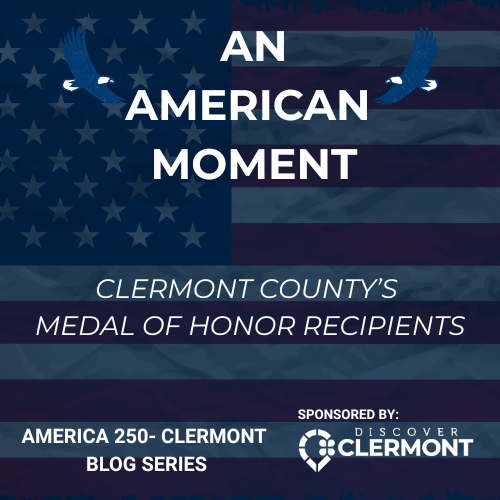The Medal of Honor is the highest decoration for valor awarded to a member of the U.S. Military while engaged in combat. It recognizes the individual for his "conspicuous gallantry and intrepidity at the risk of life above and beyond the call of duty." The medal was established by Congress to honor the actions of the members of the Andrews Raid who, dressed as civilians, infiltrated enemy lines in North Georgia on April 12, 1862. They commandeered "The General", a Confederate locomotive, and ran it towards Union lines, ripping up train tracks and destroying telegraph lines along the way. The Raiders were overtaken before they completed their mission. Eight of them, including its civilian leader James Andrews, were hanged as spies. Six of the men received the medal. Ohioan Jacob Parrott was the first recipient.
Two Clermonters, John Wageman of Clover (Williamsburg) and Edgar R. Aston of Bethel were awarded the medal for service in the Civil War and the Apache Indian Wars, respectively.
John Wageman
John Wageman, a fifty-six year-old farmer, strolled over to the Clover post office. He had been told that a letter from the War Department was waiting for him. Wagemen must have wondered what this was all about. After all, it had been thirty-one years since his discharge from the army.
The letter was short and to the point. Was he the Private John Wageman of Company L, 60th Ohio Volunteer Infantry who was wounded at Petersburg, Virginia? He answered that he was and returned the letter to the War Department.
About a month later, a small package from the War Department addressed to Wageman arrived at the post office. Inside was a Medal of Honor. What did Wageman think about receiving the medal? Did it conjure up memories of dead comrades? Was he proud or did he think he was just doing his duty? Unfortunately, we'll probably never know the answers to those questions.
Wageman was twenty-three years old when he enlisted in the army. He had brown hair, hazel eyes, and at 5'9" tall, he was above average in height. Private Wageman and his regiment arrived in Virginia in time to take part in the Great Overland Campaign of 1864, led by fellow Clermonter General U.S. Grant. The 60th saw hard service, fighting in the Battles of Spotsylvania, The Wilderness, Cold Harbor and the Crater at Petersburg.
The 60th received orders on June 16, 1864, to move to Petersburg, Virginia to outflank the Confederates of General Robert E. Lee. The men of the 60th marched all through the night and the next day, only to find that Lee's men had beat them there. The 60th was ordered to the line and began firing at the Rebs. Wageman was struck by a Minnie ball in his left thigh and collapsed in a heap. He refused to be taken from the field until he had fired off all his cartridges. He was later taken to a hospital and treated for his wound.
How long was Wageman on the field? It is hard to say. There are no direct records answering that question. The average allotment of cartridges were forty per man. Firing a musket was cumbersome and time consuming. A proficient rifleman could load and fire his gun twice per minute. Wageman's wound added to the time it took to exhaust his ammunition. Although we'll never know how much time he spent on the firing line after he was shot, it was clearly noteworthy.
Wageman' recovery from the shooting was complicated when he contracted diphtheria while in the hospital. He lost his hearing for two months because of the disease. After discharge from the army, he returned to Clover. Wageman got married, raised a son, and became a deacon at his church. He died at age 75 and was buried in the Clover Cemetery. A new headstone recognizing his status as a Medal of Honor recipient was dedicated in 1999.
Edgar R. Aston
Edgar R. Aston was born in New Richmond in 1846. His father William died three years later, leaving his wife Emmeline penniless and unable to care for Edgar and his sister Hattie. He was declared a ward of the state and moved to Bethel to live with relatives.
He got his first taste of army life in 1864 when he enlisted in the 153rd Ohio Volunteer Infantry, a National Guard unit ordered to Federal Service during the summer of 1864. The 153rd was composed of many Clermonters, including future Ohio Governor John M. Pattison. They were sent to West Virginia to guard vital train links and important military sites. He liked army life and enlisted in the regular army after the war.
He was assigned to Company L of the 8th U.S. Cavalry, based at San Carlos, Arizona. Edgar arrived in Arizona during the Apache Wars. There were no major battles fought in the various outbreaks of violence. Instead, the war was carried out in skirmishes, raids and counter raids and hit and run attacks fought in the unforgiving terrain of southeast Arizona. The army faced the Chiricahua Apaches led by Cochise.
On May 30, 1868, Aston was out in the field with a column of infantry that had become trapped in a mountain pass. Aston, Thomas Cumberly and an unnamed trooper volunteered to find a way out of the mess.
Aston's Medal of Honor citation tells the story.
"With two other men he volunteered to search for a wagon passage out of a 4,000-foot mountain valley wherein an infantry column was immobile. This small group passed six miles through hostile Apache terrain, finding the sought passage. On their return trip down the canyon they were attacked by Apaches, who were successfully held at bay."
He received his medal just two months after the incident.
Aston retired from the army after thirty years of service. He returned to Bethel. He died on April 14, 1932, and is buried at the Tate Township Cemetery.


